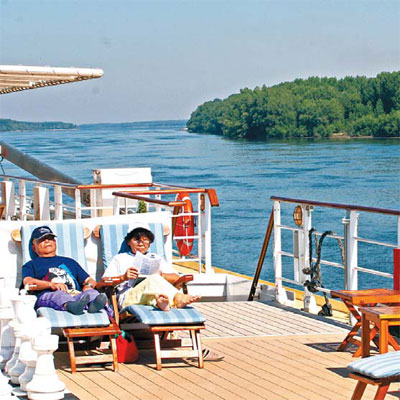|

|
|
Tourists reading a book or napping in the sun while taking a cruise on the Danube. |
The lady in orange lowered her camera - "We've come too late," she sighed.
It was 8:30 am on a bright morning in the Danube delta, the sunshine already so hot that the birds - pelicans, great white egrets and spoonbills - crouched in the shade and were hard to photograph.
Before emptying into the Black Sea, the Danube River branches into an enchanting wetland of lakes, streams and channels where reed belts, water-lily ponds and sand dunes alternate with woods. A UNESCO World Cultural Heritage site, the Danube delta has been declared a "biosphere reserve" by the United Nations' cultural body.
A delta tour is quite different from the classic route of Passau, Germany, to Vienna, Austria. An excursion to Romania's Black Sea port of Constanta and nearby resort of Mamaia revealed the lingering poverty in this fledgling member of the European Union. Streets were full of potholes, gray villages and many houses were in need of a repair.
Fields were devoid of tractors and there were plough horses with rack wagons instead. But a wagon driver waved cheerfully, and gardens gleamed with ripe fruit in summery colors: pink peaches, orange apricots, yellow mirabelles.
Hundreds of cranes stretched skyward in Constanta. New schools and shops were built in the city after the fall of Communism. But rusting cars with flat tires littered the streets during a recent visit, and priceless Greco-Roman exhibits in the Natural History and Archaeological Museum lay in dusty glass cases guarded by bored personnel.
The beach in Mamaia is flanked by a shopping strip with kebab stands, bakeries, restaurants, inflatable bouncing castles for children and carousels. Mamaia is not a seaside resort in the classic sense. About 80 large hotels dot the coastline. The tourist season ends abruptly in early September, and there is no off-peak season.
The crowded beach was reminiscent of those on the Adriatic Sea, with one sun lounger after another and clusters of sun umbrellas. Bathing was somehow unappealing even though the water was clear and had a temperature of 25 C.
The boat arrived the following day at the Bulgarian port of Ruse. The bus, landscape and towns in Bulgaria looked much tidier than those in Romania. Sights in Veliko Tarnovo, situated on a Danube tributary, include the attractive town center and ruins of the medieval fortress Tsarevets on the hill of the same name.
The neighboring village of Arbanassi, a place of cobblestone streets and houses with red tile roofs, looked as though it could be in Tuscany. Its architecture is worth seeing, particularly the 16th-century Church of the Nativity of Christ with its frescoes.
A day later, a few sightseeing-sated travelers stayed on board, settled into deck chairs and let the green banks of the Danube glide by.
On the passage through the Carpathian Mountains, one side of the river is Romanian and the other Serbian. The most wildly romantic stages of the tour came next: the Kazan Gorge - between the Romanian city of Orsova and the Serbian city of Donji Milanovac - and the Iron Gate.
From here it was not long before the riverboat reached Hungary - time for an outing to a stud farm in the puszta, the Great Hungarian Plain.
Budapest is unbeatable as the starting and end point of a river cruise, though the Hungarian capital's population is dwindling. No depopulation was evident in the historic city centre near the port, however.
There are about 80 mineral spring in the city, where the Turks built numerous baths as early as the 16th century.
It is said that the site of the famous Hotel Gellert, on the Danube, was occupied in the 13th century by a hospital that utilized the curative effects of the mineral spring there.
(China Daily March 19, 2009)